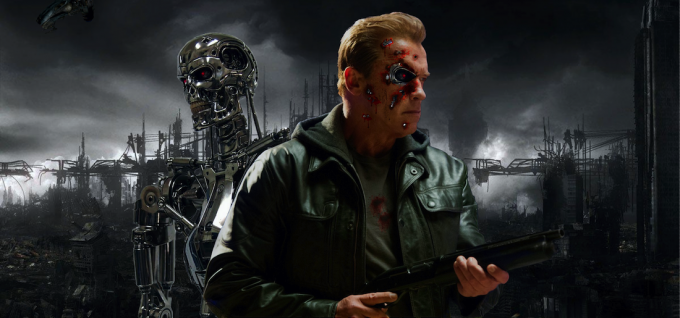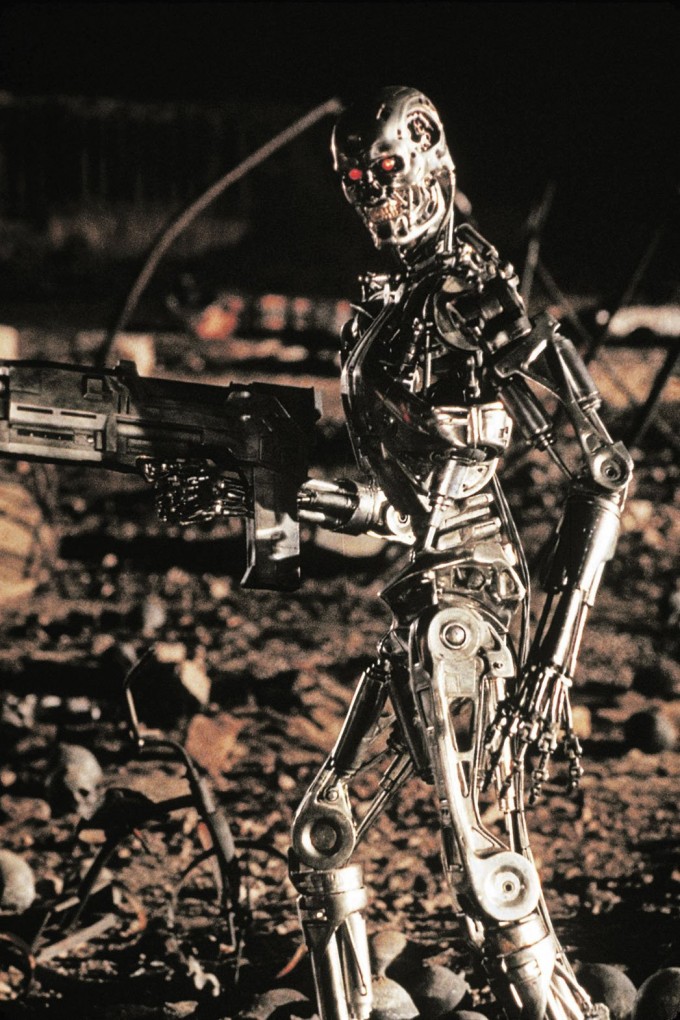
With the latest installment of the Terminator franchise hitting cinemas this summer, now seems like a good time to check in and see how the robot uprising is going in the real world. Rather alarmingly the answer is quite well.
Cyberdyne, the company behind Skynet and the Terminators actually exists. In real life!
Thanks to the crazy people that we let design and create all of our technical jiggery pokery, the latest Terminator movie may soon be considered more of a documentary than a piece of entertainment as science has created some truly weird and wonderful steps towards making the age of machines possible.
1) The Impressionist

Terminators are killer robots sent back from the future to wipe out mankind. In their bag of tricks they have super human strength, almost indestructible bodies and possibly most worrying of all, the ability to copy people’s voices.
In all four of the current terminator movies the cunning machines have used their creepy vocal talents to lure people into various traps, so for some reason science thought that this would be a great place to start making Terminator come true.
This frankly disturbing set of robo chops is the work of Kagawa University in Japan and features artificial vocal chords, an air pump and even a nasal cavity.
The bizarre device is made out of silicon and plaster to accurately mimic the structure of a human vocal system, allowing it to accurately create sounds created by people. It’s also linked up to a sound analyser so that it can learn from the noises other people make and improve the way it speaks.
As if the disembodied mouth wasn’t bad enough there are also talking robots out there that are learning to speak like us too.
The video above stars Jules who is crammed full of software and dialogue written by professional writers that allows it to hold a full conversation with people, maintaining eye contact, turning to face them as they move around and even responding with facial reactions and body gestures to what is said.
Jules has been known to hold conversations on topics as complicated as sexuality and the clip above was taken just before the robot was packed off to the University of West England in Bristol, where it hopes its creators will come and visit it…
2) Death from above

Among the robotic creations of the Terminator franchise are the hunter killers, unmanned drones that fly around taking out targets from the sky.
Back in 1984, when the first Terminator movie came out military drones were barely a twinkle in the eyes of the armed forces with the sinister Predator drone, used heavily in recent conflicts by the CIA, not even in the planning stages.
This has all changed today with drone technology so easily available that you pop down the road and grab one from your local Argos.
Drones are now used for everything from filming movies and taking photos to racing round the forest with your mates.

In military terms drones have come on in leaps and bounds too. From supersonic missiles fitted to the latest Predators to Iranian suicide drones and even a recently discovered drone landing at the Whitehouse it seems the world has gone drone crazy.
Drone development has even reached the point where the little blighters can work together in teams!
Hunter Killers aren’t just around the corner, they’re already here. And to rub that fact more firmly in our faces some Russians have taken a punt at making the first real life model. Thanks Russia.
3) Slippery customer

The liquid metal terminator which first appeared in Terminator 2 is one of the toughest robots in all of sci-fi, able to change its body into almost any shape and heal bullet wounds faster than Wolverine.

The metallic liquid seemed to have a mind of its own in the movie and so science decided that a silvery snot bubble of death was exactly what the world needed next.
Originally invented as a rocket fuel, ferrofluids are a mixture of tiny particles containing iron and a liquid such as water. The really cool thing about them is that when you introduce them to a magnet they take on some truly crazy shapes and can even become spongy and firm to the touch.

What you might have noticed is that most of these shapes are pretty spiky and not the pleasingly rounded shapes that would be required to mimic a human body. This is because of the liquid’s surface tension which limits the shapes you can create with it.
But now some brainiacs at North Carolina State University have figured out how to change all that, using electricity to get the fluids to do pretty strange stuff
Yep that’s right, you just watched liquid metal go round a corner on purpose. Officially this is going to be used to create better circuits and “self repairing structures” which we all know is code for: “We’re making our own Robert Patrick robot.”
4) Skin jobs

So you’re building a killer robot and you need it to look like like a human? Well then Japanese robotics Professor Hiroshi Ishiguro is your guy.
The professor decided that A) making a weirdly human looking robot was a good idea and that B) Obviously the least freaky choice for a face was his own.
Because everyone wants to watch a strangely twitchy version of themselves stuck in a chair while a science minion pokes it in the face with their finger.
Hiroshi’s ‘Geminoid’ isn’t the only automaton that could pass for a person either, it looks like the whole of Japan are working at it. The pair in the clip above again have some strangely realistic facial expressions.
They can hold conversations with humans and even with each other. This stops here people, before they get organised…
5) Two legs are better than none

Ok you’ve got the human skin suit and the ability to pass for human in the speech department, but underneath you still need a badass robot skeleton that can carry all that technology around and generally mess stuff up.
In what can only be a global conspiracy, the ‘geniuses’ at DARPA (that’s America’s Defence Advanced Research Projects Agency) have decided to create one. And when we use the word ‘geniuses’ sarcastically it’s because they are the same group of people that created this:
Why? Just WHY? There is no need for a robot cheetah/crab nightmare that can run at 28mph! And DARPA don’t stop there. No, they’ve also made a donkey that can throw bricks:
Thankfully neither of these monstrosities could pass for human and it’s reassuring to know that the nuances of even simple human movements like walking up the stairs can be pretty difficult to master.
Isn’t that right Honda?
But the march of progress is relentless and so it seems is DARPA’s desire to make horrific sci-fi come true. Here for your viewing pleasure is a double dose of robotic parambulation – the Atlas and Petman:
You’ll notice how the Atlas looks a little geriatric, shuddering up the stairs and using its hand to steady itself. Well OAP robots we can probably handle but Petman is an entirely different problem.
Designed to test chemical weapons suits, the Petman deliberately copies human movement and can even sweat to provide realistic test conditions. You can check out Petman in a full suit below.
Now that we’re even preparing the robots for war is it any wonder this two legged bad boy is already practising his victory fist pump.
6) Half man, half machine

According to Terminator lore machines can only make it through the rigors of time travel by being coated in flesh.
Given everything we’ve already mentioned it will probably come as no surprise that German scientists in Stuttgart are already teaching robots to make human skin.
The Fraunhofer Institute’s ‘Flesh Factory’ is eventually hoping to produce complex human organs but for now it manufactures a variety of skin tones, which should give the machines a nice variety of coverings for the latest Terminator models.
On top of that there are already DIY cyborgs like Neil Harbisson, who has had an antenna surgically attached to his skull so that he can hear sounds.
He’s not alone either as there are plenty of other bio-hackers out there adding bits and pieces to themselves, including documentary maker Rob Spence who had a camera fitted into his right eye after it was damaged in a shooting accident.

The one eyed cameraman apparently has a variety of prosthetic eyes that he can pop in and out but probably the most telling is this little number.

So we’ve lost Rob, but it seems the machines are making their biggest moves in the realm of medical replacements.
This is Nigel Ackland who, after losing his arm in an accident, can now type, cook and pour beer with his new robotic arm. The electronic limb is powered by tiny muscle movements proving that flesh and robotics are already getting along much better than you might expect.
The fact that it looks pretty much like the terminator arm which kicked off the events of Terminator 2 is just coincidence. Honest.
7) Cyberdyne exists

Walking robots and flesh factories not enough for you? Well here’s the real kicker, Cyberdyne, the company responsible for creating Terminators actually exists! In the real world. And does it make cuddly bunny toys or slippers for grandma? No, it makes freaking robots!

Founded in 2004 by university professor Dr. Yoshiyuki Sankai, Cyberdyne Inc. specialises in creating exo-skeletons for use in medicine and industry. The robot suits make people much stronger than normal allowing them to carry heavy objects and even other people with ease.
The company’s signature model, the Hal 5, demonstrates an alarming sense of humour which references the villainous computer of the same name from 2001: A Space Odyssey and the ominous signs don’t end there.
The company’s website also mentions creating a ‘global network’ which should set alarm bells ringing because in the movies it was Cyberdyne’s global digital defence network, Skynet, that told the terminators to wipe out mankind in the first place.

It really seems like Dr Sankai is trying to mess with our heads. Above is a picture of Cyberdyne’s headquarters in Japan, and below is the Cyberdyne visitors attraction at Universal studios in Japan.

Yeah, suspiciously similar right? Which makes “funny” photos like this seem all the more terrifying…

You may also like:
The US Navy Have Unveiled Their Latest Gadget: A Million Dollar Robot Drone Shark
Introducing Marbel: The Lightest Electric Skateboard In The World!